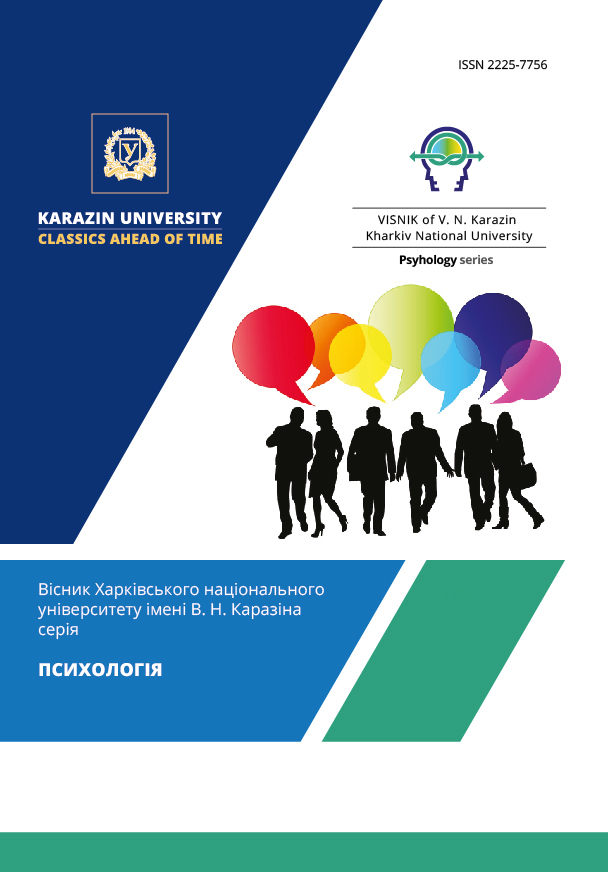До питання ставлення до смерті людей середнього віку під час війни в Україні
Анотація
На ставлення людини до смерті впливають критичні ситуації, з якими вона зіткається в своєму житті. Війна, яка розпочалася в Україні на початку 2022 року, зробила актуальними переживання людини з приводу смерті, адже смерть стала повсякденною реальністю в житті українців. Мета дослідження: визначити особливості ставлення людей середнього віку до феномену смерті під час війни в Україні. Вибірка досліджуваних (N=76), які раніше брали участь у наших дослідженнях в 2019 та 2020 роках під час коронавірусної інфекції. Вік досліджуваних варіюється: Me=44.00; min=35.00; max=55.00. Методи дослідження: методика «Ставлення до смерті» (І.Ю. Кулагіна, Л.В. Сенкевич), методика «Шкала ставлення до смерті» D.V. Hardt, методика Metaphor of Personal Death – the Revised Death Fantasy Scale (RDFS) J. McLennan. Було визначено, що ставлення до смерті людей досліджуваної середньовікової групи під час війни є амбівалентним з певним відхиленням у бік позитивних. Для досліджуваної групи характерним є середній рівень стресостійкості, який пов'язаний з думками про смерть. Вибір метафор про смерть визначається ступенем позитивності ставлення до смерті: песимістичне ставлення до смерті пов’язане з негативними роздумами про смерть, фіксації на її зовнішній стороні, уникненні контакту зі смертю. Відсутність бачення позитивної перспективи у смерті призводить до світоглядної неприкаяності та негативних думок. Оптимістичне ставлення до смерті пов’язане з рідкою появою негативних думок про власну смерть, сприйняття смерті як необхідної сторони буття, відкритість для контактів зі смертю. Були визначені значущі розбіжності між віруючими та атеїстами за показником позитивних думок з приводу власної смерті: віруючі люди виявили високий рівень прийняття смерті. Також було визначено значущі розбіжності в ставленні до смерті між чоловіками та жінками: чоловіки більш позитивно та з «чорним» гумором ставляться до думок про смерть.
Завантаження
Посилання
Cardozo, B., Vergara, A., Agani, F. et al. (2000). Mental Health, Social Functioning, and Attitudes of Kosovar Albanians Following the War in Kosovo. JAMA, 284(5), 569-577. https://doi.org/10.1001/jama.284.5.569
Cardozo, B.L., Bilukha, O.O., Crawford, C.A., Shaikh, I., Wolfe, M.I., Gerber, M.L., Anderson, M. (2004). Mental health, social functioning, and disability in postwar Afghanistan. JAMA, 4(292), 575-584. https://doi.org/10.1001/jama.292.5.575.
De Jong, K., Van der Kam, S., Ford, N. (2004). Trauma of Chechnya's ongoing war on internally displaced people. Lancet, 1. http://www.uk2.msf.org/reports/chechnya.htm
De Jong, K., Van der Kam, S., Ford, N., Hargreaves, S. et. al. (2007). The trauma of ongoing conflict and displacement in Chechnya: quantitative assessment of living conditions, and psychosocial and general health status among war displaced in Chechnya and Ingushetia. NL of M, 1. https://doi.org/10.1186/1752-1505-1-4.
Dvornyk, M.S., Myronchak, K.V. (2021). Innovative means of psychological assistance to the individual in the conditions of hybrid war. Kyiv. https://lib.iitta.gov.ua/728210/1/
Feifel, H. (1993). The Problem of Death. Illness, Crisis & Loss, 3(1), 29–34. https://doi.org/10.2190/IL3.1.e.
Fischer, I.C., Secinti, E. (2022). Examination of the relationships between religiosity and death attitudes in Turkey and the United States. Death Studies, 46(1), 157-167. https://doi.org/10.1080/07481187.2020.1723742.
Forther, B.V., Neimeyer, R.A. (1999). Death Anxiety in Older Adults: a Quantitative Review. Death Studies, 23(5), 387-411.
Freud, Z. (1993). Reflections upon War and Death. (Ph. Rieff, Ed.). New York: Collier Books.
Granville-Chapman, C. (2004). Rape and other torture in the Chechnya conflict: documented evidence from asylum seekers arriving in the United Kingdom, 4. http://www.torturecare.org.uk/publications/reportChech.htm
Hardt, D.V. (1975). Development of an investigatory instrument to measure attitudes toward death. Journal of School Health, 45, 96–99. https://doi.org/10.1111/j.1746-1561.1975.tb07672.x.
Kulagina, I.Yu. (2013). Attitude to death: age, regional and gender differences. Kulturno-ystorycheskaia psykholohyia, 9(4), 58–64.
Levinson, D. J., & Gooden, W. E. (1985). The life cycle. (H. I. Kaplan & B. J. Sadock, Eds.), Baltimore, MD: Williams and Williams.
Mironchak, K.V. (2012). Psychological impact of the fear of death on personality. Naukovyi visnyk Lvivskoho derzhavnoho universytetu vnutrishnikh sprav. seriia psykholohichna, 2(2), 361-370.
Mollica, R.F., McInnes, K., Sarajlić, N., Lavelle, J., Sarajlić, I., Massagli, M.P. (1999). Disability associated with psychiatric comorbidity and health status in Bosnian refugees living in Croatia. JAMA, 282(5). https://doi.org/10.1001/jama.282.5.433
Mollica, R.F., Sarajlic, N., Chernoff, M., Lavelle, J., Vukovic, I.S., Massagli, M.P. (2001). Longitudinal study of psychiatric symptoms, disability, mortality, and emigration among Bosnian refugees. JAMA, 286(5). https://doi.org/10.1001/jama.286.5.546
Morris Trainor, Z., Jong, J., Bluemke, M., & Halberstadt, J. (2019). Death Salience Moderates the Effect of Trauma on Religiosity. Psychological Trauma: Theory, Research, Practice, and Policy, 11(6), 639-646. https://doi.org/10.1037/tra0000430
Neimeyer, R.A., Wittkowski, J., Moser, R.P. (2004). Psychological research on death attitudes: an overview and evaluation. Death Studies, 28(4), 309-40. https://doi.org/10.1080/07481180490432324.
Psychological diagnostics: the "Death Attitude Scale" technique (Dale Hardt V.). https://sites.google.com/site/test300m/skos
Rose, M. Fighting for peace: Bosnia, 1994. (1999). New York: Time Warner Paperbacks.
Salama, P., Spiegel, P., Van Dyke, M., Phelps, L, Wilkinson, C. (2000). Mental health and nutritional status among the adult Serbian minority in Kosovo. JAMA, 284(5). 578-584. https://doi.org/10.1001/jama.284.5.578
Sinoff, G. (2017). Thanatophobia (Death Anxiety) in the Elderly: the Problem of the Child’s Inability to Assess Their Own Parent’s Death Anxiety State. Frontiers in Medicine, 4. https://doi.org/10.3389/fmed.2017.00011
Smith, P., Perrin, S., Yule, W., Hacam, B., Stuvland, R. (2002). War exposure among children from Bosnia-Herzegovina: psychological adjustment in a community sample. Trauma Stress, 15(2). 147-156.
Westermeyer, J. (2000). Health of Albanians and Serbians following the war in Kosovo: studying the survivors of both sides of armed conflict, JAMA, 284(5), 615-626. https://doi.org/10.1001/jama.284.5.615
Yalom, I. Staring at the sun. Overcoming fear. (2020). Kharkiv: KSD.
Yanovska, S., Turenko, R., Timchenko, V. (2020). Attitudes to Death of Middle-Aged in the Context of the Covid-19 Pandemic. Visnyk of V.N. Karazin Kharkiv National University. Series “Psychology”, 69, 55 - 63. https://doi.org/10.26565/2225-7756-2020-69-08




